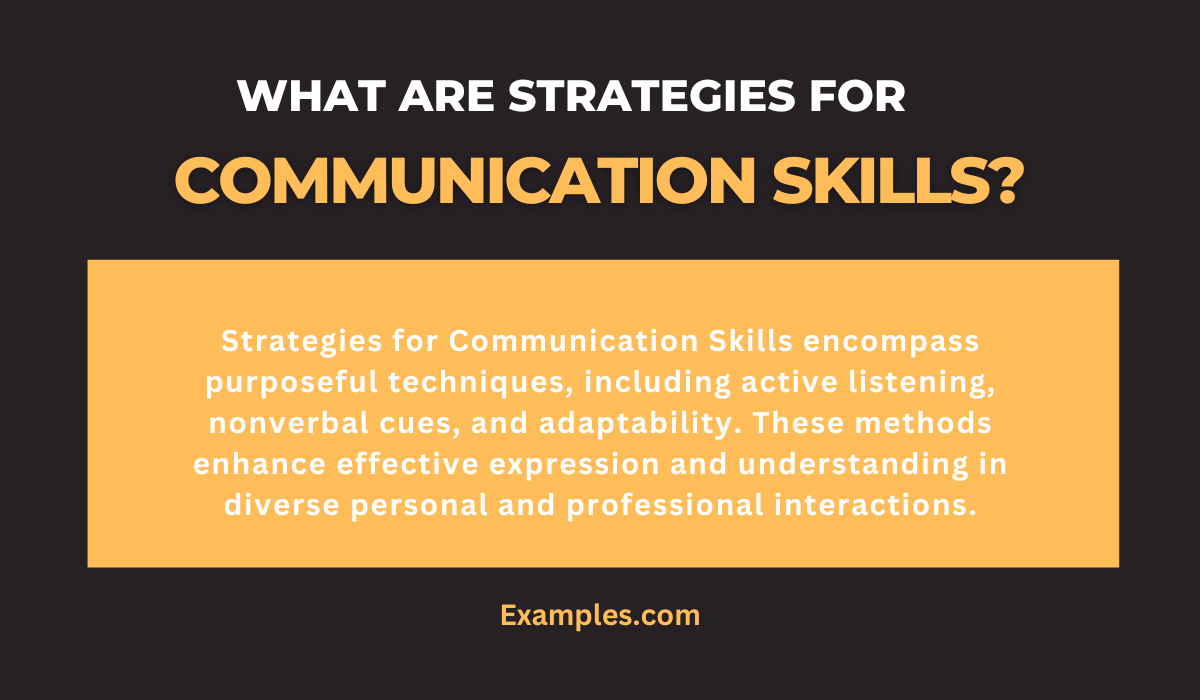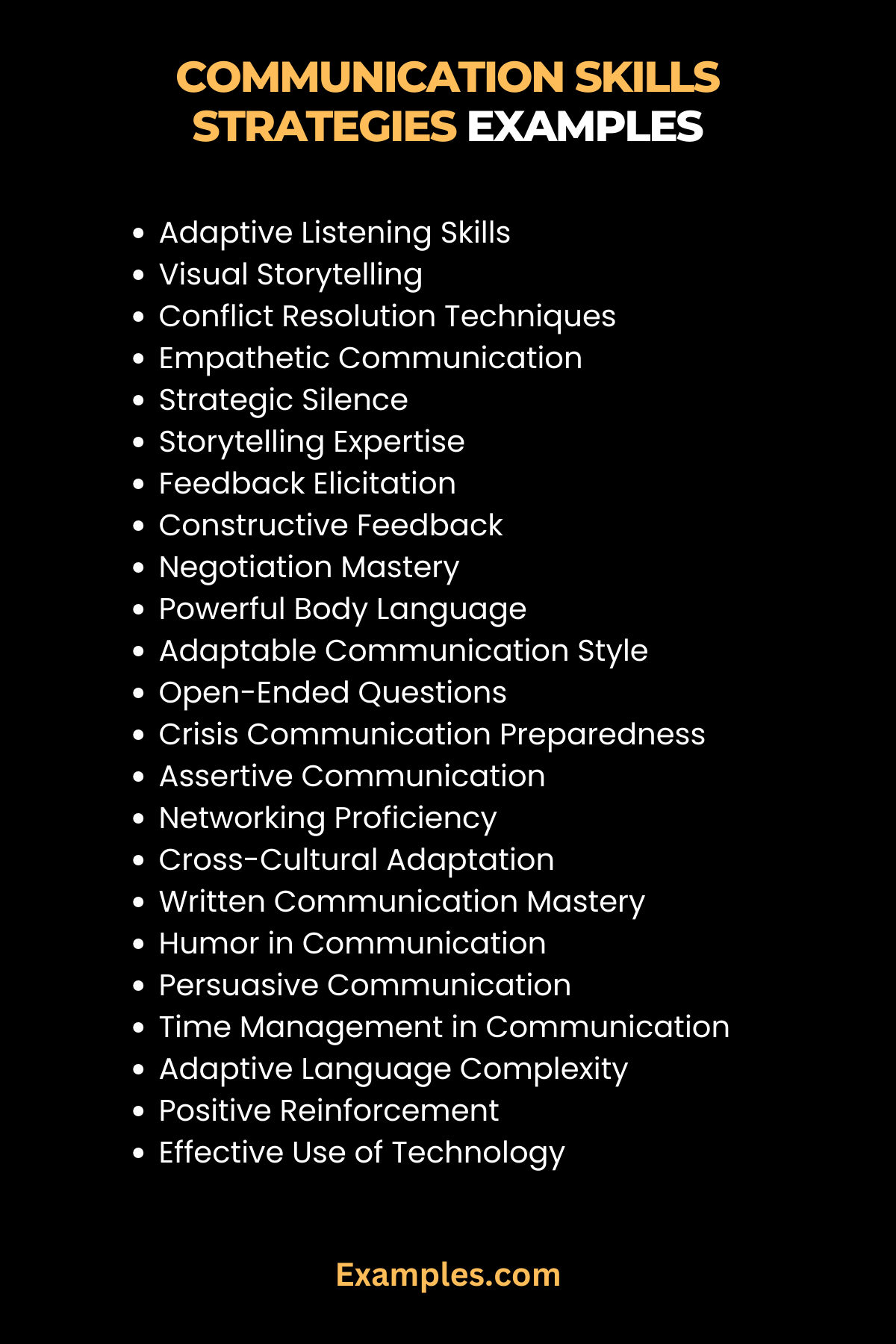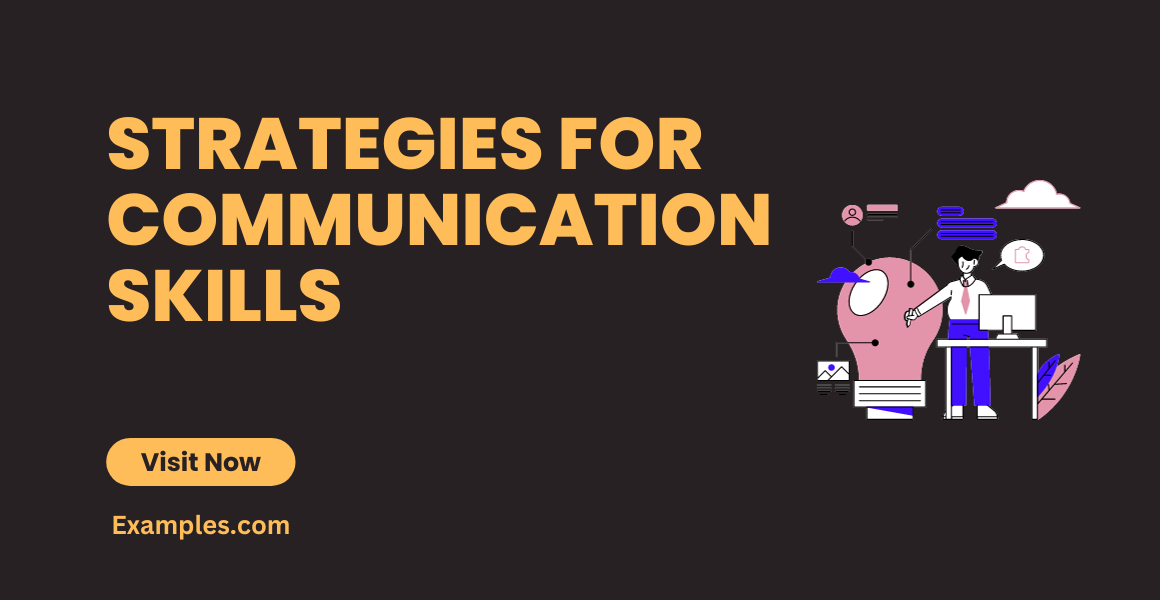29+ Strategies For Communication Skills Examples
Embark on a comprehensive exploration of Strategies for Communication Skills, delving into impactful methods that transcend diverse scenarios. Uncover practical examples, expert tips, and powerful strategies to enhance your ability to express and comprehend messages effectively. This guide is your roadmap to navigating the intricacies of communication, offering insights that span interpersonal relationships, professional settings, and personal growth. Whether you’re a student, professional, or seeking improvement in your daily interactions, these strategies are tailored to elevate your communication finesse. Unlock the full potential of Communication Examples in this detailed guide.
What are Strategies For Communication Skills?
Strategies for Communication Skills encompass a repertoire of techniques designed to optimize the exchange of information. These strategies go beyond mere verbal articulation, incorporating nonverbal cues, active listening, and contextual adaptation. In essence, they are deliberate approaches employed to enhance the clarity, impact, and understanding of messages in diverse communication settings. Embracing these strategies empowers individuals to navigate conversations effectively, fostering meaningful connections and promoting successful outcomes in various aspects of life.

30 Strategies For Communication Skills Examples
Unlock the art of effective expression with these Strategies for Communication Skills examples. Each method is a powerful tool to enhance your communicative finesse in various scenarios:

- Active Listening: Demonstrate understanding by paraphrasing and responding actively during conversations.
- Visual Storytelling: Convey complex ideas through compelling visuals, enhancing comprehension and engagement.
- Conflict Resolution Techniques: Navigate conflicts diplomatically, fostering a harmonious and cooperative environment.
- Empathetic Communication: Express understanding and empathy, building stronger connections in conversations.
- Strategic Silence: Use deliberate pauses to emphasize points, allowing for reflection and understanding.
- Constructive Feedback: Provide feedback in a positive and constructive manner, promoting growth and improvement.
- Powerful Body Language: Utilize confident gestures and posture, reinforcing the verbal message with nonverbal cues.
- Mindful Expression: Choose words consciously to convey thoughts clearly and avoid potential misunderstandings.
- Adaptable Communication Style: Adjust your communication approach to suit diverse audiences and contexts effectively.
- Open-Ended Questions: Encourage in-depth discussions by posing questions that invite thoughtful responses.
- Crisis Communication Preparedness: Address crises with transparency, ensuring clear and reassuring communication during challenging times.
- Assertive Communication: Express opinions confidently, promoting clarity and understanding in professional and personal interactions.
- Networking Proficiency: Navigate networking events adeptly, creating connections through effective and engaging conversations.
- Cross-Cultural Adaptation: Adjust communication methods to bridge cultural gaps, fostering universal understanding.
- Written Communication Mastery: Craft written messages with precision, ensuring clarity and coherence in written interactions.
- Humor in Communication: Employ humor judiciously to lighten the atmosphere and create a positive, engaging communication environment.
- Persuasive Communication: Influence opinions by employing persuasive language and compelling arguments in discussions.
- Time Management in Communication: Convey messages efficiently, respecting time constraints and maintaining a well-paced communication flow.
- Adaptive Language Complexity: Tailor language complexity to match the comprehension level of your audience for better understanding.
- Positive Reinforcement: Acknowledge and reinforce positive behaviors and contributions through affirming communication.
- Effective Use of Technology: Leverage communication technologies for seamless interaction, especially in remote or virtual settings.
- Feedback Loop Creation: Establish a continuous feedback loop, fostering an environment of open communication and improvement.
- Visualization Techniques: Use descriptive language to create mental images, aiding understanding in various communication contexts.
- Facilitation of Group Discussions: Guide and facilitate group discussions, ensuring all voices are heard and contributions valued.
- Storytelling Expertise: Weave compelling narratives to make messages memorable and impactful in various communication scenarios.
- Adaptive Listening Skills: Adapt listening techniques to different communication situations, ensuring effective comprehension.
- Personalized Communication Approach: Tailor communication methods to suit individual preferences, fostering stronger connections.
- Team Building Communication: Promote teamwork through effective communication that emphasizes collaboration and shared goals.
- Adaptation to Communication Channels: Adjust communication style based on the chosen channel, whether verbal, written, or virtual.
- Multitasking Communication: Efficiently handle multiple communication tasks simultaneously, demonstrating versatility in diverse scenarios.
Strategies For Communication Skills Examples For Students
Elevate academic success and interpersonal connections with tailored Strategies for Communication Skills. Students can employ active listening during group projects, articulate ideas confidently in presentations, and utilize positive affirmations for effective peer collaboration. Nonverbal communication awareness becomes crucial in discussions, and adapting communication styles enhances teamwork. Embracing emotional intelligence aids conflict resolution, and soliciting feedback fosters continuous improvement. These strategies empower students to navigate diverse communication contexts, laying the foundation for academic achievement and future professional success. These strategies cater to academic and personal growth, empowering students to articulate ideas, collaborate effectively, and navigate diverse communication scenarios.
- Active Participation: Engage in classroom discussions actively, contributing ideas and perspectives.
- Effective Note-Taking: Capture key information during lectures to aid comprehension and retention.
- Collaborative Group Projects: Communicate efficiently within study groups, fostering teamwork and shared success.
- Clarity in Presentations: Convey ideas clearly in presentations, ensuring understanding among peers and instructors.
- Professional Email Etiquette: Craft emails with professionalism, clarity, and respect for effective communication with professors and peers.
- Constructive Peer Feedback: Provide and receive constructive feedback, promoting a culture of mutual growth.
- Time Management Communication: Communicate effectively about project timelines and expectations, ensuring smooth collaboration.
- Inclusive Language Use: Employ language that fosters inclusivity, creating a welcoming environment for all students.
- Online Collaboration Skills: Master virtual communication tools for seamless online collaboration on projects and assignments.
- Conflict Resolution in Group Settings: Navigate conflicts within study groups by using effective communication and conflict resolution techniques.
Strategies For Communication Skills Examples at Work
Navigate the dynamic landscape of the workplace with impactful Strategies for Communication Skills. Active listening fosters effective collaboration, while adaptability in communication styles enhances interactions with diverse colleagues. Strategic use of tone and pitch adds nuance to presentations, and clarity in articulation ensures concise messaging. Visual storytelling becomes a powerful tool in conveying complex ideas, and crisis communication preparedness demonstrates composure during challenging moments. These strategies empower individuals to excel in professional environments, fostering positive work relationships, and contributing to overall workplace success. From effective team collaboration to leadership communication, these examples empower individuals to excel in diverse work environments.
- Leadership Communication: Convey a compelling vision and inspire teams with clear and motivational communication.
- Conflict Resolution in the Workplace: Address workplace conflicts diplomatically, fostering a positive and productive work atmosphere.
- Strategic Decision Communication: Effectively communicate key decisions, ensuring understanding and alignment within the team.
- Performance Feedback: Provide constructive performance feedback, fostering professional growth among team members.
- Client Presentation Skills: Master the art of client presentations, conveying ideas persuasively and professionally.
- Effective Meeting Communication: Lead and participate in meetings with clarity, purpose, and concise communication.
- Cross-Departmental Collaboration: Communicate seamlessly across departments, ensuring cohesive teamwork and project success.
- Crisis Communication Management: Navigate crisis situations with transparent and empathetic communication to reassure and guide the team.
- Negotiation and Persuasion: Negotiate effectively by employing persuasive communication techniques for favorable outcomes.
- Email Communication Efficiency: Craft emails with brevity and clarity, ensuring efficient communication in the fast-paced work environment.
Strategies For Communication Skills Examples at Home
Harmonize familial relationships with Strategies for Communication Skills tailored for home environments. Positive affirmation creates a supportive atmosphere, while conflict resolution techniques navigate family challenges effectively. Quality time planning through collaborative communication strengthens bonds, and mindful technology use agreements ensure a balanced family dynamic. Celebrating achievements reinforces positive behavior, and adaptive language complexity ensures clarity in communication. These strategies enable family members to navigate daily interactions with understanding, fostering a nurturing and communicative home environment for shared growth and well-being.Navigate various situations effectively, fostering understanding and connection within your household.
- Active Listening During Family Meetings: Listen attentively to family members during discussions, ensuring everyone feels heard and valued.
- Conflict Resolution Through Open Dialogue: Address conflicts openly, expressing concerns and finding resolutions collaboratively.
- Positive Affirmation in Daily Conversations: Incorporate positive affirmations to uplift family members during routine interactions.
- Empathetic Communication in Challenging Moments: Express understanding and support during family challenges, fostering emotional connection.
- Clear Communication of Household Expectations: Clearly communicate expectations to avoid misunderstandings and promote a harmonious atmosphere.
- Family Goal-Setting Discussions: Engage in family meetings to set collective goals, encouraging shared aspirations and collaboration.
- Mindful Technology Use Agreements: Establish agreements on technology use, ensuring everyone is aligned with family guidelines.
- Celebrating Achievements with Effective Communication: Celebrate individual and family achievements, expressing pride and reinforcing positive behavior.
- Quality Time Planning Through Collaborative Communication: Plan family activities collaboratively, ensuring everyone’s interests and preferences are considered.
- Supportive Communication During Family Challenges: Offer support and understanding during challenging times, fostering a sense of unity and resilience.
What are Types of Communication Skills Strategies?
Understanding and employing diverse communication strategies is key to effective interaction. Explore the table below for a comprehensive overview of various types of Communication Skills Strategies:

Why are Communication Skills Strategies Important in Our Daily Lives?
Communication Skills Strategies play a pivotal role in our daily lives, influencing various aspects for personal and professional growth:
- Navigating Relationships:
- Effective strategies foster understanding, strengthening bonds in personal and professional relationships.
- Conflict Resolution:
- Strategies provide tools for resolving conflicts, ensuring harmonious interactions in diverse scenarios.
- Career Advancement:
- Proficient communication strategies contribute to career success, enhancing leadership and teamwork capabilities.
- Promoting Positive Environments:
- Strategies create positive atmospheres at home and work, fostering collaboration, trust, and mutual respect.
- Achieving Personal Goals:
- Communication strategies aid in setting and achieving personal goals, aligning actions with aspirations.
- Enhancing Emotional Intelligence:
- Strategies contribute to emotional intelligence, enabling individuals to navigate emotions and respond effectively.
- Facilitating Teamwork:
- Effective communication fosters teamwork, ensuring collective efforts and shared goals are understood and realized.
- Optimizing Problem-Solving:
- Strategies aid in clear communication during problem-solving, ensuring efficient resolution and preventing misunderstandings.
- Building a Supportive Network:
- Proficient communication establishes a supportive network, enabling individuals to seek guidance and share experiences.
- Continuous Personal Growth:
- Regular use of communication strategies fosters a culture of continuous improvement, learning, and adaptation.
What are Powerful Strategies to Improve Your Communication Skills?
Enhancing communication proficiency involves adopting powerful strategies tailored to diverse contexts. Elevate your interaction finesse with these impactful approaches:
- Active Listening Mastery:
- Engage fully in conversations, demonstrating attentive and empathetic listening to understand others genuinely.
- Nonverbal Communication Awareness:
- Cultivate awareness of body language, gestures, and facial expressions, aligning nonverbal cues with verbal messages for enhanced impact.
- Adaptability in Communication Styles:
- Tailor your communication style to match diverse audiences and situations, fostering understanding and connection.
- Emotional Intelligence Integration:
- Develop emotional intelligence to navigate and express emotions effectively, promoting positive interactions and conflict resolution.
- Feedback Solicitation and Implementation:
- Actively seek feedback, incorporating constructive insights into your communication approach for continuous improvement.
- Strategic Use of Tone and Pitch:
- Harness the power of tone and pitch variations to convey emotions and emphasis, adding depth to your verbal communication.
- Clarity in Articulation:
- Articulate thoughts clearly, avoiding ambiguity and ensuring your message is easily understood by others.
- Visualization Techniques:
- Utilize descriptive language to create vivid mental images, enhancing comprehension and engagement in communication.
- Contextual Adaptation:
- Adjust your communication methods to fit specific contexts, acknowledging the impact of environment on effective interaction.
- Crisis Communication Preparedness:
- Equip yourself with strategies to communicate effectively during challenging situations, ensuring composure and transparency.
Tips for Effective Strategies For Communication Skills
Navigating the intricacies of communication requires a strategic approach. Here are valuable tips to optimize your implementation of effective communication strategies:
- Consistent Self-Reflection:
- Regularly reflect on your communication style, identifying areas for improvement and recognizing successful strategies.
- Continuous Learning Mindset:
- Embrace a mindset of continuous learning, staying informed about evolving communication trends and strategies.
- Adaptation to Diverse Audiences:
- Recognize the diversity of your audience and adapt your communication strategies to ensure universal understanding.
- Utilization of Technology:
- Leverage communication technologies to streamline processes, especially in virtual or remote settings.
- Collaborative Goal Setting:
- Engage in collaborative goal-setting discussions, aligning family, team, or organizational objectives for cohesive efforts.
- Regular Family Meetings:
- Conduct regular family meetings, fostering open communication and addressing concerns collectively.
- Incorporation of Positive Affirmations:
- Infuse positive affirmations into daily conversations, creating a supportive and uplifting communication atmosphere.
- Empathetic Response in Challenges:
- Respond empathetically during challenging moments, fostering emotional connection and understanding.
- Encouragement of Open Dialogue:
- Cultivate an environment of open dialogue, encouraging transparent communication and constructive feedback.
- Celebration of Achievements:
- Celebrate individual and collective achievements, reinforcing positive behavior and acknowledging shared success.
In conclusion, this comprehensive guide illuminates the diverse Strategies for Communication Skills, offering practical examples and insightful tips. From academic success to professional growth and harmonious family dynamics, these strategies empower individuals in various contexts. Implementing these proven methods ensures effective communication, fostering understanding, collaboration, and success across personal and professional spheres.



